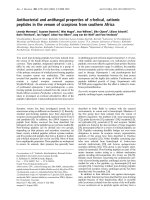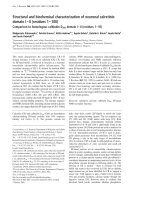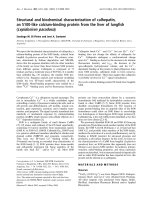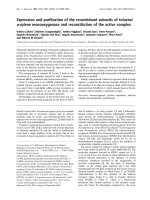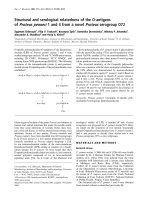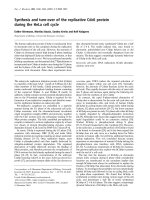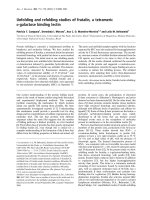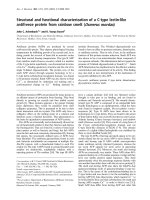Báo cáo y học: "Clinical and laboratory characteristics of drug-induced vasculitic syndromes Allan Wiik" potx
Bạn đang xem bản rút gọn của tài liệu. Xem và tải ngay bản đầy đủ của tài liệu tại đây (32.93 KB, 2 trang )
191
ANA = antinuclear antibody; ANCA = antineutrophil cytoplasmic antibody; DIV = drug-induced vasculitis; IV = idiopathic vasculitis.
Available online />Abstract
Clinical recognition of drug-induced vasculitic and lupus-like
syndromes is very important because continued use of the
offending drug can lead to irreversible and life-threatening vasculitic
organ damage (e.g. end-stage renal disease or pulmonary
haemorrhage). Withdrawal of the drug often leads to spontaneous
recovery, meaning that immunosuppressive therapy can be avoided.
The presence of myeloperoxidase–antineutrophil cytoplasmic
antibodies, IgM anticardiolipin antibody, and antihistone antibodies
in combination was found to be characteristic of drug-induced
vasculitic syndromes caused by the antithyroid drugs
propylthiouracil and methimazol. Clinically, skin vasculitis and
arthralgias predominated and renal vasculitis was rare.
Introduction
The differential diagnosis between drug-induced and
idiopathic vasculitic conditions may be difficult in the individual
patient. Because the mere withdrawal of the offending drug in
the former situation is usually sufficient to attain complete
remission of clinical symptoms, the distinction between these
syndromes is very important. Failure to recognize a
relationship with a drug can lead to fatal organ damage.
The report by Branka Bonaci-Nikolic and coworkers [1]
included in this issue of Arthritis Research and Therapy is a
good example of clinical research aimed at identifying details
that can aid in distinguishing between seemingly related
syndromes, such as idiopathic vasculitides (IVs) and drug-
induced vasculitides (DIVs). The clinical importance of
recognizing patients with DIV is great because withdrawal of
the offending drug usually leads to resolution of the syndrome
without further therapy, whereas the IVs must always be
treated with immunosuppressive and anti-inflammatory drugs,
and sometimes even with plasmapheresis.
The study included 72 consecutive patients who had been
found to be positive for antineutrophil cytoplasmic antibodies
(ANCAs) directed at proteinase-3 or myeloperoxidase. Twenty-
nine of these patients suffered from Wegener’s granulomatosis,
23 from microscopic polyangiitis, four from Churg–Strauss
syndrome, and 16 from a DIV caused by either propylthiouracil
or methimazol. All sera were additionally studied for presence of
antinuclear antibodies (ANAs), antihistone and anticardiolipin
antibodies, cryoglobulins, complement factors C3 and C4, C-
reactive protein and α
1
-antitrypsin.
Cutaneous vasculitis was found to be most common in the DIV
patients, being present in 63%, whereas it was found in only
25% of the IV patients. In contrast, renal vasculitis was seen in
75% of the IV patients but only in 19% of the DIV patients.
Four of the DIV patients presented with symptoms compatible
with an IV-like syndrome (one Wegener’s granulomatosis, three
microscopic polyangiitis), whereas 12 patients had a lupus-like
syndrome. Thirteen of the 56 IV patients died and eight
developed terminal renal failure, whereas there were no deaths
and only one terminal renal failure in the DIV group.
Especially interesting findings in this study pertain to the
laboratory results. DIV patients were mostly positive for
myeloperoxidase–ANCAs and were positive for ANAs and
antihistone antibodies, and had high levels of IgM
anticardiolipin antibodies and low C4 values. This contrasted
with absence of ANAs, antihistone and anticardiolipin
antibodies, and normal C4 levels in patients with IV.
The study thus concludes that ANCA positive IV patients
have a more severe disease course than do patients with DIV.
More important, though, is that DIV commonly presents as a
lupus-like illness accompanied by serological findings that are
distinctly different from those seen in IV. The lower C4 values
in the DIV patients indicate complement consumption by
immune complexes, and this assumption was supported by
the finding of slightly higher cryoglobulin values in these
Commentary
Clinical and laboratory characteristics of drug-induced vasculitic
syndromes
Allan Wiik
Department of Autoimmunology, Statens Serum Institut, Copenhagen, Denmark
Corresponding author: Allan Wiik,
Published: 24 August 2005 Arthritis Research & Therapy 2005, 7:191-192 (DOI 10.1186/ar1805)
This article is online at />© 2005 BioMed Central Ltd
See related research by Bonaci-Nikolic et al. in this issue [ />192
Arthritis Research & Therapy October 2005 Vol 7 No 5 Wiik
patients. The fact that DIV patients also harboured high
serum levels of IgM anticardiolipin antibodies indicates that
DIV patients may be at risk for developing venous or arterial
thrombosis or experience pregnancy loss [2]. It may also
mean that prophylaxis against such complications should be
discussed in DIV patients with the lupus-like syndrome.
There are data in the literature indicating that a lupus-like DIV
may develop as a result of antithyroid drug therapy [3].
Authors generally agree that DIV syndromes have a better
long-term prognosis mostly because of lesser renal involve-
ment. Arthralgias and skin vasculitis are prominent features in
these patients, and the clinical manifestations usually subside
after withdrawal of the offending drug. Nevertheless, some
patients go on to develop serious vasculitic manifestations if
the offending drug therapy is not stopped [4].
Several authors have pointed to the presence of ANCAs
directed at more than one neutrophil cytoplasm antigen as a
characteristic feature of DIV [4,5]. Others have observed a
characteristic development of ANAs and antihistone anti-
bodies as well as myeloperoxidase–ANCAs in such patients,
the latter being likely to be caused by drug-induced damage
directed at the neutrophils that process the drug [6].
The observation that DIV patients can also develop high
levels of IgM anticardiolipin antibodies is partly new. There
are very few data in the literature on anticardiolipin antibodies
in the IV syndromes, but in cases in which this has been
observed the prognosis appeared to be worse because of
the development of more extensive lesions.
The development of DIV in conjunction with propylthiouracil
or methimazol therapy in patients with Grave’s disease is
likely to depend on genetic predisposition [7]. Thus, among
monozygotic triplets who all developed Grave’s disease in
their childhood, two were treated with propylthiouracil and
one with carbimazol. The two who received propylthiouracil
both developed a DIV with skin vasculitis and pronounced
arthralgias, whereas the patient who was treated with
carbimazol did not.
Conclusion
In conclusion, when a patient manifests prominent skin
vasculitis reminiscent of lupus combined with other features
of a lupus-like condition, a DIV syndrome should be
suspected. Long-term treatment with antithyroid drugs can
lead to DIV in genetically predisposed persons, and thus
laboratory surveillance follow up is advisable. According to
suggestions raised by the report presented in this issue, this
should include monitoring of ANCAs, ANAs and
anticardiolipin antibodies. Hopefully, this diagnostic approach
will lead to better recognition and cure of DIV in the future.
Competing interests
The author(s) declare that they have no competing interests.
References
1. Bonaci-Nikolic BM, Nikolic MM, Andrejevic S, Zoric S, Bukilica M:
Antineutrophil cytoplasmic antibodies (ANCA)-associated
autoimmune diseases induced by antithyroid drugs: Compari-
son with idiopathic vasculitides. Arthritis Res Ther 2005, 7:
R1072-R1081.
2. Roubey RAS: Autoantibodies to phospholipid-binding plasma
proteins: a new view of lupus anticoagulants and other
‘antiphospholipid autoantibodies’. Blood 1994, 84:2854-2867.
3. Thong HY, Chu CY, Chiu HC: Methimazole-induced antineu-
trophil cytoplasmic antibody (ANCA)-associated vasculitis
and lupus-like syndrome with a cutaneous feature of
vesiculo-bullous lupus erythematosus. Acta Dermatol Venereol
2002, 208:206-208.
4. Choi HK, Merkel PA, Walker AM, Niles JL: Drug-associated anti-
neutrophil cytoplasmic antibody-positive vasculitis: preva-
lence among patients with high titers of antimyeloperoxidase
antibodies. Arthritis Rheum 2000, 43:405-413.
5. Kitahara T, Hiromura K, Maesawa A, Ono K, Narabara N, Yano S,
Naruse T, Takenouchi K, Yasumoto Y: Case of propylthiouracil-
induced vasculitis associated with anti-neutrophil cytoplasmic
antibody (ANCA); review of literature. Clin Nephrol 1997, 47:
336-340.
6. Rubin RL: Autoantibody specificity in drug-induced lupus and
neutrophil-mediated metabolism of lupus-inducing drugs.
Clin Biochem 1992, 25:223-234.
7. Herlin T, Birkebaek NH, Wolthers OD, Heegaard NH, Wiik A:
Antineutrophil cytoplasmic antibodies (ANCA) prophiles in
propylthiouracil-induced lupus-like manifestations in monozy-
gotic triplets with hyperthyroidism. Scand J Rheumatol 2002,
31:46-49.

